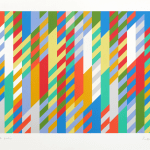


Bridget Riley (b. 1931)
Gouache on paper
66 by 87 cm. 26 by 34½ in.
Framed: 75.5 by 96.5 cm. 29¾ by 38 in
Further images
Provenance
Gallery Fine Limited, London
Private Collection, Europe
Private Collection, acquired from the above by the present owner circa 2010
Fortescue & Oldfield
Literature
Sotheby’s Essay
Representing a transitional moment in Bridget Riley’s momentous career, 1st Study for Painting and Bassacs exemplify the introduction of a new pictorial complex for the artist, a systemic shift from the robust diagonals and curves of her earlier work to the exploration into the divergent and jarred rhomboid. Constructing new visual relationships between the forms of these interplaying shapes, Riley focuses on the junction between the vertical and diagonal, disrupting the harmony of her previous colour work to explore the relationship between broken tones. The architectural structure of the interlocking rhomboid highlights the collaboration and often clashing conflict between the differing tonal qualities and unpacks the symmetry of colour theory which will occupy Riley’s practice for the next ten years.
1st Study for Painting and Bassacs sees a shift from the weighted density of the artist’s Egypt Paintings where Riley had a visceral response to her visit to the Nile valley, subsequently producing a series of large scale striped canvas’ from 1980-85. These fundamental works on paper mark the artist’s step away from linear simplicity and the beginning of Riley’s exploration to this new form of colour relationship.
“Riley’s respect for perception allows her to enter into dialogue with her own artistic process. Her work is very precise, like that of the Op artists with whom critics once associated her; but she never experiences total control of her vision. Nor would she wish to. The effects she seeks inhabit an illusive medium”
(RICHARD SHIFF, ‘BRIDGET RILEY: THE EDGE OF ANIMATION’, IN: EXH. CAT., LONDON, TATE BRITAIN, BRIDGET RILEY, 2003, P. 84).


